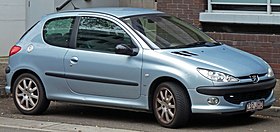Naza 206 Bestari
| Peugeot 206 | |
|---|---|
 |
|
| Overview | |
| Manufacturer | Peugeot |
| Also called | Peugeot 206+ (Europe) Peugeot 207 Compact (Latin America) Citroën C2 (China) Naza 206 Bestari (Malaysia) |
| Production | May 1998–December 2012 (France) July 1998–December 2006 (UK) 2006–2015 (China) 2003–2006 (Indonesia) 1998–2004 (Chile) April 2001–December 2014 (Brazil) July 1999–December 2016 (Argentina) April 2001– (Iran) 18-12-2012: 8.729.093 units Total: > 9.000.000 units |
| Assembly | France: Mulhouse (Mulhouse Plant) France: Poissy (Poissy Plant) Argentina: Buenos Aires (PSA Argentina) Brazil: Porto Real (PSA Brazil) Chile: Los Andes (PSA Chile) China: Wuhan (DPCA) Indonesia: Jakarta (Gaya Motor) Iran: Tehran (Iran Khodro) Malaysia: Gurun (NAM) United Kingdom: Ryton (Ryton Plant) Uruguay: Barra de Carrasco (Oferol) |
| Designer | (206) Murat Günak (206 CC) |
| Body and chassis | |
| Class | Supermini (B) |
| Body style | 3/5-door hatchback 2-door coupé cabriolet 4-door sedan 5-door station wagon |
| Layout | Front-engine, front-wheel-drive |
| Related |
Citroën C2 Citroën C3 Peugeot 1007 IKCO Runna |
| Powertrain | |
| Engine | 1.0 L D4D I4 (petrol) 1.1 L TU1JP I4 (petrol) 1.4 L TU3JP I4 (petrol) 1.4 L ET3J4 I4 (petrol) 1.4 L TU3JP I4 (petrol) 1.4 L TU3A I4 (petrol) 1.6 L TU5JP I4 (petrol) 1.6 L TU5JP4 I4 (petrol) 2.0 L EW10J4 I4 (petrol) 2.0 L EW10J4S I4 (petrol) 1.4 L DV4 HDi I4 I4 (diesel) 1.6 L DV6 HDi I4 (diesel) 1.9 L DW8 I4 (diesel) 2.0 L DW10 I4 (diesel) |
| Dimensions | |
| Wheelbase | 2,442 mm (96.1 in) |
| Length | 3,835 mm (151.0 in) (hatchback) 4,000 mm (157.5 in) (coupé cabriolet) 4,188 mm (164.9 in) (sedan, Europe) 4,235 mm (166.7 in) (sedan, South America) 4,028 mm (158.6 in) (station wagon) |
| Width | 1,652 mm (65.0 in) (hatchback) 1,652 mm (65.0 in) (coupé cabriolet) 1,655 mm (65.2 in) (sedan) 1,652 mm (65.0 in) (station wagon) |
| Height | 1,428 mm (56.2 in) (hatchback) 1,373 mm (54.1 in) (coupé cabriolet) 1,456 mm (57.3 in) (sedan) 1,460 mm (57.5 in) (station wagon) |
| Kerb weight | 1,025–1,145 kg (2,260–2,524 lb) |
| Chronology | |
| Predecessor | Peugeot 205 |
| Successor | Peugeot 207 |
The Peugeot 206 is a supermini car that was produced by the French manufacturer Peugeot from May 1998 to December 2012, however the Peugeot 206 models are still in production in Iran.
Even though the 206 had finished production in most markets by 2010, in Europe it was available as the 206+, with front and rear styling that resembles the Peugeot 207, until 2013, whereas in South America it continued to be offered under the 207 nameplate, until January 2017. and furthermore in China, both under the 207 nameplate and as the Citroën C2.
It was officially launched in September 1998 in hatchback form, which was followed by a coupé cabriolet (the 206 CC) in September 2000, a station wagon (the 206 SW) in September 2001, and a sedan version (the 206 SD) in September 2005.
Its facelifted version was initially launched in South America in September 2008, and in China in November 2008, in hatchback, sedan and station wagon body styles, and known as the 207 Compact, and as the 207 respectively. This version was subsequently launched in Europe in February 2009, only in hatchback form and marketed as the 206+.
In November 2006, the Chinese joint venture Dongfeng Peugeot-Citroën launched a derivative version of the Peugeot 206 known as the Citroën C2, but not technically related with the European-market model.
Peugeot 206 is best selling Peugeot all of time with approximate 8.358.217 cars sold. Until 2016, used Peugeot 206 is still in the top 10 of UK's used car sales comparing to the others new models of other brands.
During the early 1990s, Peugeot decided not to directly replace the Peugeot 205, citing the reason that superminis were no longer profitable or worthwhile. Instead, Peugeot followed a unique strategy and decided that its new, smaller, supermini, the Peugeot 106 (launched in 1991) would take sales from the lower end of the 205 range while the lowest models of the Peugeot 306 range, launched in 1993 to replace the Peugeot 309, would take sales from the top-end 205s. Between the 106 and 306, Peugeot hoped that the 205 would not need to be replaced, and could be phased out slowly, while customers who would normally plump for the 205 would continue to have a choice with either a smaller or larger car. Unfortunately for Peugeot, this strategy did not work. With the 205 phased out, other superminis like the Ford Fiesta and Volkswagen Polo continued to sell well and even increased in popularity, and without a direct competitor to these cars Peugeot was losing sales fast. A new supermini was required, and the 206 was launched in 1998 as a somewhat belated replacement for the 205. Peugeot hired the world famous Italian designer Pinifarina to make it the most beautiful against it's competitors.
...
Wikipedia
